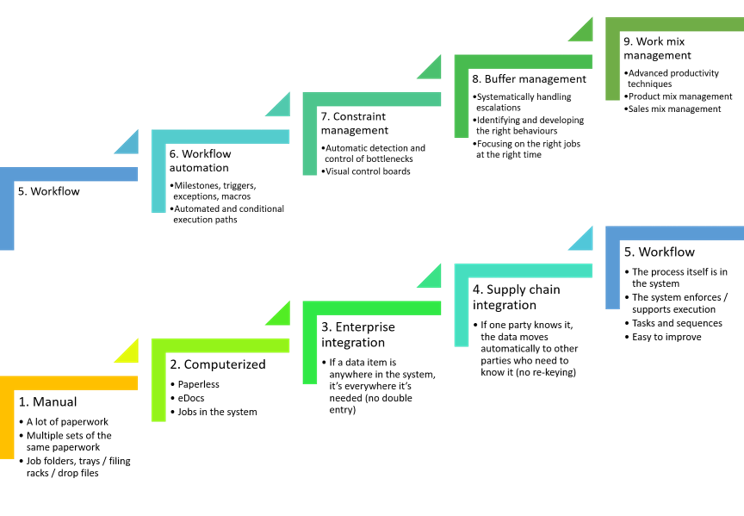Understanding the Nine Phases of Productivity - The Nine Phases
The Nine Phases of Productivity chunks what would be a big, comprehensive business growth project into a series of install effects, each of which incrementally increases:
- The output of the system with minimal increase in resourcing, "We are more productive"
- The profitability and growth of the system, "Our cash flow is better"
“Well, this could be a three or four-year project but it’s not disruptive because it’s deliberately designed to be business-as-usual as much as possible.
Phases One to Four are a focus on data (data handling and data availability)
Initially, businesses increase leverage by buying/hiring and delegating to obtain more capacity. To increase leverage, businesses seek to automate, eliminate, and reduce the time taken to complete tasks. Processes are established and then codified into standard operating procedures. A step change occurs…
- Phase One - Manual, “Everything is printed and filed”
- Phase Two - Computerised, “It’s all in the system”
- Phase Three - Enterprise Integration, “If data is anywhere in your system, it’s everywhere in your system”
Phases Five and Six are a focus on processes (operating procedures and their automation)
The focus moves from enhancing individual productivity to enhancing the flow of work. Jobs start involving multiple resources. There are milestones and people’s activity becomes dependent on handovers from other people. Staff begin to be specialised and the management of flow, rather than individuals, moves to the forefront of operational consideration. Bottlenecks start to appear and resourcing conflicts develop. Another step change occurs…
- Phase Four – Supply Chain Integration, “Sharing data with customers and other businesses in the supply chain”
- Phase Five – Workflow, “Job progress is clearly visible”
- Phase Six – Workflow Automation, “Automation of human tasks”
Phase Seven to Nine are a focus on management methodology (the management of risk and value-adding strategy)
Leverage becomes available from managing variability and risk. Management focus is on minimising work-in-progress in order to accelerate flow. The meta-processes of the business become levers to access substantial productivity gains.
- Phase Seven – Constraint Management, “Getting more control over your workload”
- Phase Eight – Buffer Management, “Managing 'at-risk' jobs before they cause damage”
- Phase Nine – Work Mix Management, “Managing the sales and work mix to optimise throughput”
